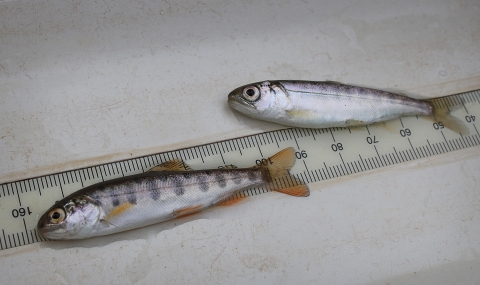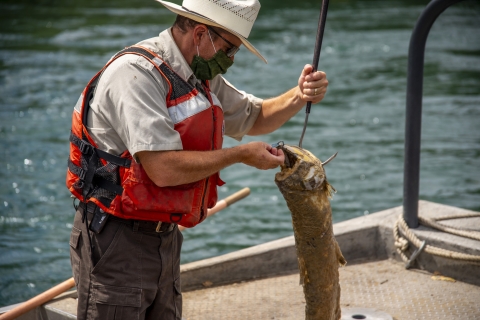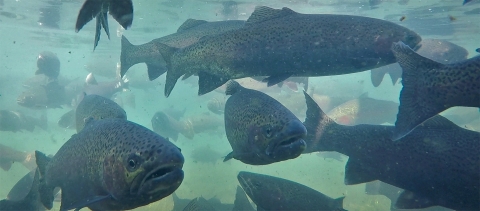Hatchery Evaluation Program, Red Bluff Fish and Wildlife Office
Construction and operation of Shasta Dam resulted in the loss of approximately 187 miles of spawning and rearing habitat for salmonids. The Service produces fall and late-fall Chinook salmon at Coleman National Fish Hatchery to mitigate for this loss of habitat and the subsequent reduction in salmonid populations. Fall and late-fall Chinook salmon are produced at the hatchery primarily to contribute to harvest in the ocean commercial fishery, ocean sport fishery and freshwater sport fishery, as well as to provide adequate returns to the hatchery for broodstock broodstock
The reproductively mature adults in a population that breed (or spawn) and produce more individuals (offspring or progeny).
Learn more about broodstock . The Service intends to achieve these goals while minimizing negative effects on natural populations.
The hatchery evaluation program supports the efforts of Coleman National Fish Hatchery and Livingston Stone National Fish Hatchery to meet fish production goals, maximize contributions to fisheries, minimize negative impacts to naturally produced fish populations and conserve species.
Together, Coleman and Livingston Stone propagate three runs of Chinook salmon and steelhead. Fall and late-fall Chinook salmon and steelhead are propagated at Coleman, and endangered winter Chinook salmon are propagated at Livingston Stone.
Coleman is the largest salmon and steelhead production hatchery in the contiguous 48 states. About 12 million fall Chinook salmon, 1 million late-fall Chinook salmon, and 600,000 steelhead are produced there annually. Livingston Stone produces up to 250,000 endangered Sacramento River winter Chinook salmon each year.
Coded-wire tagging
Coded-wire tags are an important tool biologists use to manage fisheries and evaluate hatchery programs all along the Pacific coast. A coded-wire tag is a small piece of stainless steel wire, measuring about 1/4 of a millimeter in diameter and about a millimeter in length. On the barrel of the tag, a unique code is inscribed. The tag is inserted into the cartilage of the fish’s snout. Typically, the adipose fin is removed from coded-wire tagged fish as a visible mark to identify them as containing a tag. The coded-wire tag will remain in place for the entire life of the fish. When the fish is harvested or returns to the hatchery as an adult, the tag will be recovered and visually decoded with the aid of a microscope. By applying this tag to a juvenile fish and recovering it later in the fish’s life, biologists can associate information from the two life stages and gather important information that is used to make management decisions. For example, biologists use coded-wire tags and the associated fin clip to gather information such as the harvest rate and straying rate of hatchery fish.
Currently, about 4 million juvenile salmon are coded-wire tagged each year at the Coleman National Fish Hatchery, including 3 million fall Chinook salmon (25% of the hatchery’s production) and 1 million late-fall Chinook salmon (100% of the hatchery’s production). Steelhead produced at the Coleman are not currently coded-wire tagged; however, all of the steelhead produced at Coleman are marked by removing their adipose fin to identify them as being of hatchery origin. All of the winter Chinook salmon produced at the Livingston Stone National Fish Hatchery are coded-wire tagged.
Coded-wire tagging of fall Chinook salmon at the Coleman National Fish Hatchery is part of a larger basin-wide program to mark and coded-wire tag a consistent portion of fall Chinook salmon from Central Valley salmon hatcheries. This program is called the Constant Fractional Marking Program. A coded-wire tag rate of 25% has been used at Central Valley salmon hatcheries since 2007. As part of the CFM, over 8 million fall Chinook salmon are marked and tagged each year at five Central Valley salmon hatcheries. To mark and tag this large number of fish requires the use of highly sophisticated, state-of-the-art automated tagging facilities. The primary goal of the program is to estimate the relative harvest and abundance of hatchery- and naturally produced fall Chinook salmon.
Winter Chinook salmon conservation and monitoring
Sacramento River winter-run Chinook Salmon were first protected under the Endangered Species Act in 1989. Livingston Stone National Fish Hatchery was completed in 1998 for the purpose of propagating these fish to speed recovery of the population. Up to 120 returning adult winter-run Chinook salmon are captured each year and spawned in the hatchery. Adults are captured primarily at the Keswick Dam fish trap, the end point of upstream migration.
The Hatchery Evaluation Program applies the best available fish-culture practices and genetic tools to ensure the propagation program does not negatively affect the ability of the naturally reproducing population to maintain genetic integrity and adapt to future changes in their environment. Research conducted by scientists of the program and other institutions have resulted in several scientific publications that have advanced our knowledge of this species and are also applicable to salmon worldwide.
The fish produced at Livingston Stone are released into the Sacramento River. They then migrate to the ocean and mature, eventually returning to the river as adults to spawn in the wild. Winter-run Chinook salmon enter the Red Bluff and Redding areas from December through March and spawn primarily from May through July. After spawning, Chinook salmon die, and biologists use information collected from their carcasses to learn about the population.
Sacramento River carcass survey
The winter-run Chinook salmon carcass survey has been a cooperative effort between the U.S. Fish and Wildlife Service and the California Department of Fish and Wildlife dating back to 1996. The survey is conducted in the mainstem Sacramento River in the primary spawning areas of winter-run Chinook salmon, extending from the upstream limit of migration at Keswick Dam downstream to about the confluence of Cottonwood Creek.
Different reaches of the river are surveyed seven days a week from May through August. Salmon carcasses are counted and marked with metal tags. Subsequent resampling of the carcasses provides information that is used to estimate the abundance of winter Chinook salmon. Additional information collected from salmon carcasses includes gender, length, spawning location, and natural or hatchery origin. Tissue samples are collected for genetic analyses.
Our survey area can be viewed on this map.
Steelhead conservation and monitoring
Since the Coleman National Fish Hatchery steelhead program was founded in 1947, the primary goal has been to mitigate for the loss of more than 187 miles of steelhead spawning and rearing habitat due to construction of Shasta Dam. Steelhead propagated at Coleman are intended to contribute primarily to the sport fishery in the Sacramento River. Another goal is to provide adequate returns of adults back to the hatchery for broodstock. The Service attempts to achieve these goals while minimizing risks to naturally reproducing salmonids.
DNA study of Battle Creek steelhead
Central Valley steelhead were listed as threatened under the Endangered Species Act in 1998. The Fish and Wildlife Service is currently studying the ability of hatchery-raised steelhead to assist in the recovery of naturally producing steelhead populations, particularly in Battle Creek. From 1995 through 2003, adult hatchery steelhead were released into Battle Creek upstream of Coleman National Fish Hatchery to spawn naturally and aid in the re-establishment of a self-sustaining population. By collecting and examining the DNA of naturally produced adult steelhead, we can determine the origin of their parents and determine the relative reproductive success of hatchery- and natural-origin steelhead in Battle Creek.
Adult steelhead kelt migration study
Unlike salmon, which die after spawning, steelhead may survive to spawn many times during their lifetime. Information on steelhead life history in the Central Valley of California is lacking. We conducted a study using ultrasonic telemetry to better understand the migratory behavior of steelhead adults after they have spawned (also known as kelts).
Ultrasonic transmitters were surgically implanted into post-spawn hatchery steelhead at the Coleman National Fish Hatchery from 2004 through 2007. Tagged fish were released from the hatchery in April of each year. Movement of steelhead adults were monitored using a series of fixed-site receivers located throughout the Sacramento River and at the Golden Gate Bridge. Steelhead returning to the hatchery are being monitored to determine the frequency of multiple-year spawning events.
Battle Creek run size estimates
In 2003 the Hatchery Evaluation Program began a cooperative project with the California Department of Fish and Wildlife to use a video monitoring station in Battle Creek to count returns of fall Chinook salmon. Fish are forced by a weir to pass over a white sheet on the bottom of the creek. This creates a contrasting background so an image of the fish can be taken with the video camera, which is then counted by a technician. The video monitoring station provides the basis for the annual run size estimate produced by the state. Additionally, the near-real-time information on fish abundance provides a valuable tool to improve management of brood stock collections at Coleman National Fish Hatchery.
Hatchery Evaluation Program staff
Red Bluff FWO Hatchery Evaluation staff can be reached by telephone at 530-527-3043 plus the desired extension below.
Kevin Niemela, Assistant Project Leader, Phone Ext 224
Kevin Offill, Fish Biologist, Phone Ext 237
Curtis Brownfield, Fish Biologist, Phone Ext 270
Sarah Austing, Fish Biologist, Phone Ext 273
Mike Ricketts, Biological Science Technician, Phone Ext 268
Gaytha Babcock, Biological Science Technician, Phone Ext 271
Charlee Cramer, Biological Science Technician, Phone Ext 274
Robert Sheffer, Fish Biologist, Phone Ext 238




